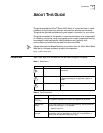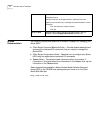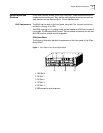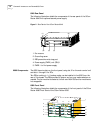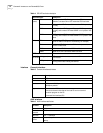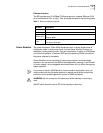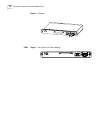
8 CHAPTER 2: INTRODUCING THE ROUTER 6000 FAMILY
packets, which implement connection between medium-and-small-sized
enterprise networks and ATM networks.
MPLS Multiprotocol Label Switching (MPLS) is a combination of IP and ATM
technologies. This method replaces the IP header with a short and length-fixed
label as traffic identifier. This information is used by the router to make forwarding
decisions. This provides faster forwarding speed while getting support from IP
routed protocols and control protocols. This meets the requirements that various
new applications put on the network. MPLS VPN is a Virtual Private Network
technology that implements the interconnection of private networks via Label
Switched Paths (LSPs). As LSP is a tunnel across the public network on its own,
MPLS has an intrinsic advantage in terms of VPN implementation. 6000 Routers
usually act as Label Edge Routers (LERs) to connect to an MPLS domain with
non-MPLS domain or connect to MPLS domains of different service providers.
Data security and
reliability
■ Support for NAT. Besides some basic functions, the NAT available for 6000 can
limit concurrent connections to a single user, and thus alleviate the negative
impact caused by malicious resources without compromising the normal
network applications. NAT of 6000 also provides the ALG (Application Layer
Gateway) function to FTP and ICMP.
■ Support the authentication protocols such as PAP, CHAP, and data RADIUS
■ Implement packet filter and stateful firewall for preventing the intrusion from
an external networks.
■ Support VPN (including GRE, L2TP, and MPLS) and provide IPSec, and IKE,
hence ensuring the security of the private networks in an Internet environment.
■ Support the Backup Center and Virtual Router Redundancy Protocol (VRRP)
technologies, enhancing the robustness and reliability of the network by
providing a backup scheme in case of communication line or device failures. So
far, backup center supports backup load sharing.
■ Support hot swap of fans, interface cards, and power module to ensure high
reliability.
Online software
upgrading
You can upgrade the application programs and Boot ROM programs, and add new
features and functions on line as needed.
Abundant fault isolation
methods
■ You can monitor the states of system configurations, system service channels,
and system resources, as well as fault indication via console and network
management host.
■ You can monitor the FIC running state by observing the LEDs on FIC panels.
■ You can use in-service system test, out-of-service system test. In addition,
loopback test and hardware key module self-test are allowed.







